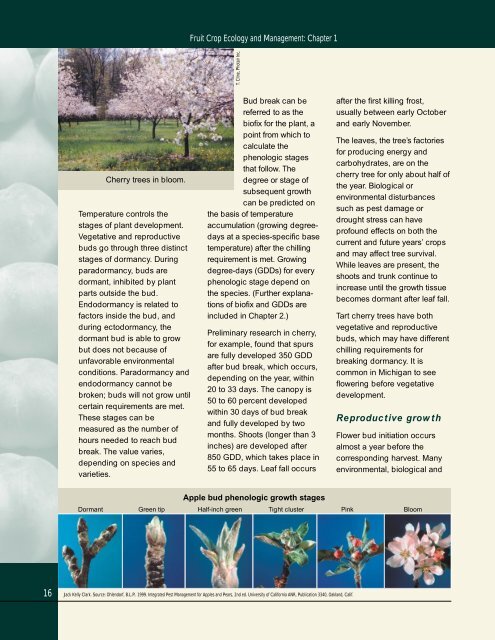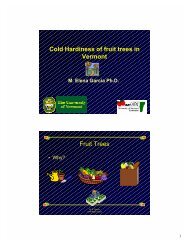Fruit Crop Ecology and Management - UVM Apple Orchard
Fruit Crop Ecology and Management - UVM Apple Orchard
Fruit Crop Ecology and Management - UVM Apple Orchard
Create successful ePaper yourself
Turn your PDF publications into a flip-book with our unique Google optimized e-Paper software.
16<br />
Cherry trees in bloom.<br />
Temperature controls the<br />
stages of plant development.<br />
Vegetative <strong>and</strong> reproductive<br />
buds go through three distinct<br />
stages of dormancy. During<br />
paradormancy, buds are<br />
dormant, inhibited by plant<br />
parts outside the bud.<br />
Endodormancy is related to<br />
factors inside the bud, <strong>and</strong><br />
during ectodormancy, the<br />
dormant bud is able to grow<br />
but does not because of<br />
unfavorable environmental<br />
conditions. Paradormancy <strong>and</strong><br />
endodormancy cannot be<br />
broken; buds will not grow until<br />
certain requirements are met.<br />
These stages can be<br />
measured as the number of<br />
hours needed to reach bud<br />
break. The value varies,<br />
depending on species <strong>and</strong><br />
varieties.<br />
<strong>Fruit</strong> <strong>Crop</strong> <strong>Ecology</strong> <strong>and</strong> <strong>Management</strong>: Chapter 1<br />
T. Cline, Photair Inc.<br />
Bud break can be<br />
referred to as the<br />
biofix for the plant, a<br />
point from which to<br />
calculate the<br />
phenologic stages<br />
that follow. The<br />
degree or stage of<br />
subsequent growth<br />
can be predicted on<br />
the basis of temperature<br />
accumulation (growing degreedays<br />
at a species-specific base<br />
temperature) after the chilling<br />
requirement is met. Growing<br />
degree-days (GDDs) for every<br />
phenologic stage depend on<br />
the species. (Further explanations<br />
of biofix <strong>and</strong> GDDs are<br />
included in Chapter 2.)<br />
Preliminary research in cherry,<br />
for example, found that spurs<br />
are fully developed 350 GDD<br />
after bud break, which occurs,<br />
depending on the year, within<br />
20 to 33 days. The canopy is<br />
50 to 60 percent developed<br />
within 30 days of bud break<br />
<strong>and</strong> fully developed by two<br />
months. Shoots (longer than 3<br />
inches) are developed after<br />
850 GDD, which takes place in<br />
55 to 65 days. Leaf fall occurs<br />
<strong>Apple</strong> bud phenologic growth stages<br />
Jack Kelly Clark. Source: Ohlendorf, B.L.P.. 1999. Integrated Pest <strong>Management</strong> for <strong>Apple</strong>s <strong>and</strong> Pears, 2nd ed. University of California ANR, Publication 3340, Oakl<strong>and</strong>, Calif.<br />
after the first killing frost,<br />
usually between early October<br />
<strong>and</strong> early November.<br />
The leaves, the tree’s factories<br />
for producing energy <strong>and</strong><br />
carbohydrates, are on the<br />
cherry tree for only about half of<br />
the year. Biological or<br />
environmental disturbances<br />
such as pest damage or<br />
drought stress can have<br />
profound effects on both the<br />
current <strong>and</strong> future years’ crops<br />
<strong>and</strong> may affect tree survival.<br />
While leaves are present, the<br />
shoots <strong>and</strong> trunk continue to<br />
increase until the growth tissue<br />
becomes dormant after leaf fall.<br />
Tart cherry trees have both<br />
vegetative <strong>and</strong> reproductive<br />
buds, which may have different<br />
chilling requirements for<br />
breaking dormancy. It is<br />
common in Michigan to see<br />
flowering before vegetative<br />
development.<br />
Reproductive growth<br />
Flower bud initiation occurs<br />
almost a year before the<br />
corresponding harvest. Many<br />
environmental, biological <strong>and</strong><br />
Dormant Green tip Half-inch green Tight cluster Pink Bloom



